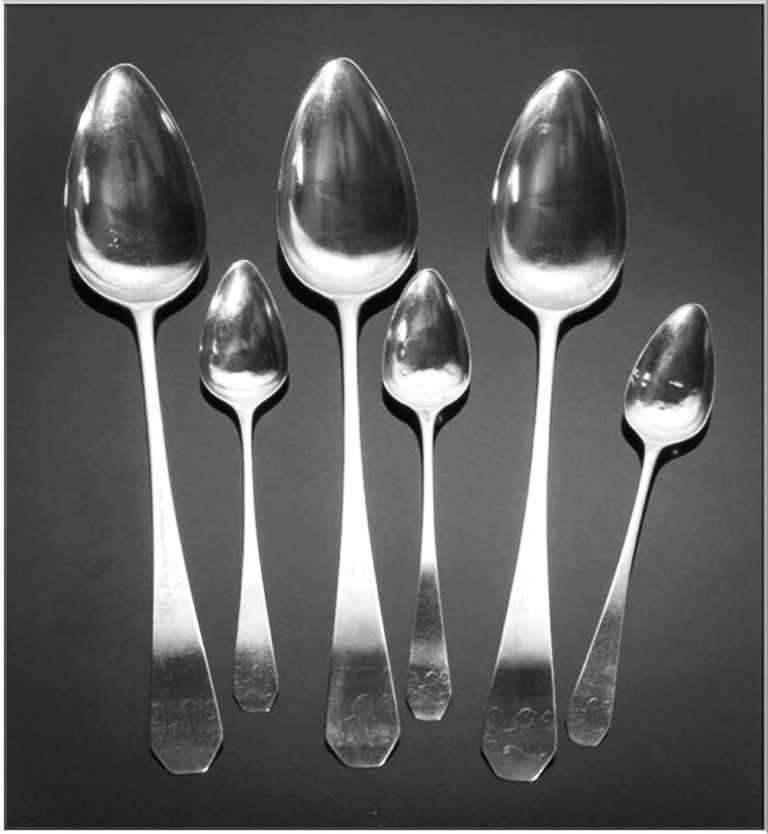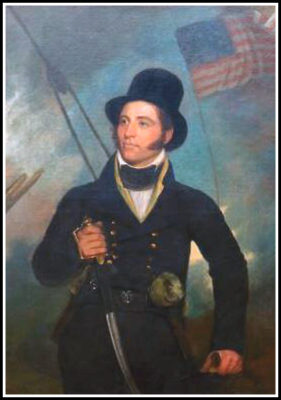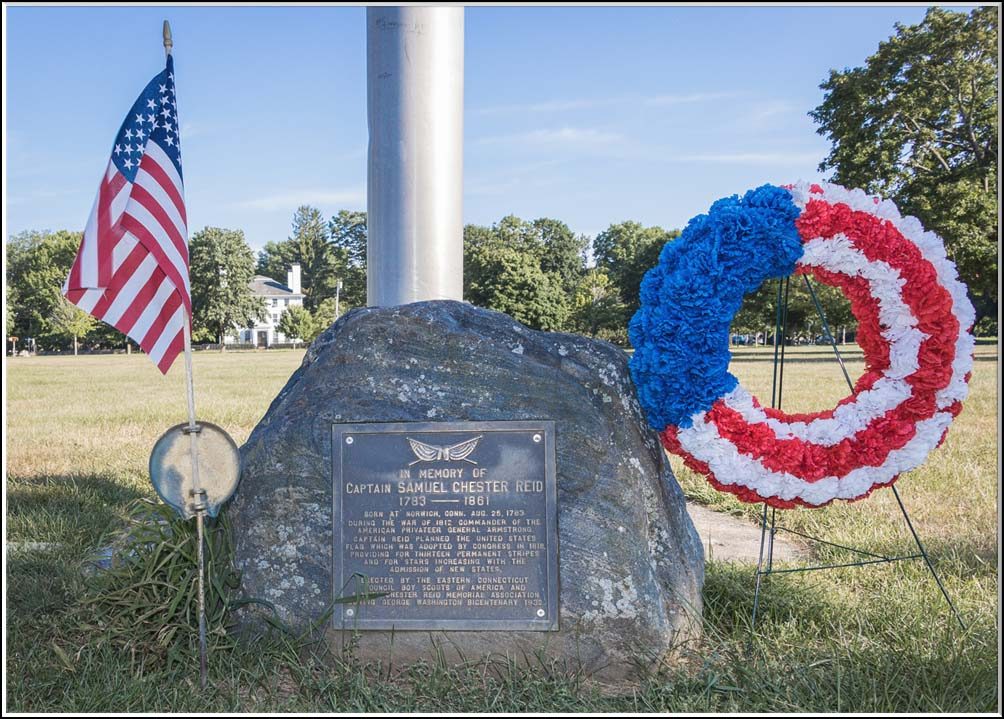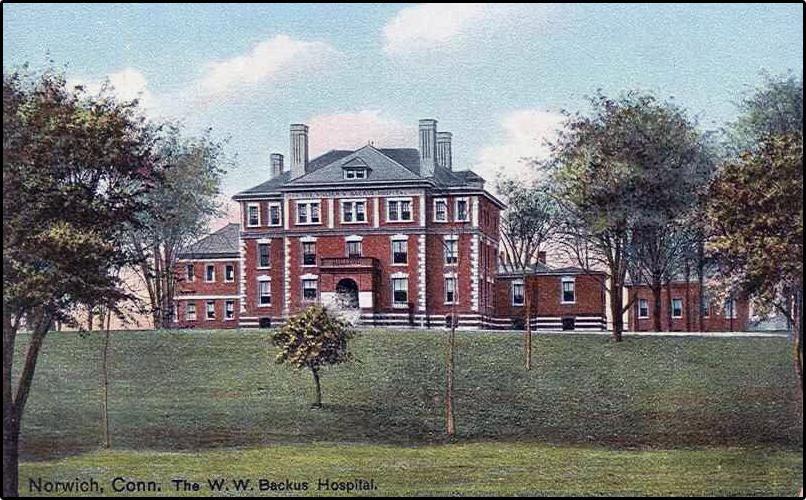Deacon William Cleveland (1769-1837)

William Cleveland, the son of Reverend Aaron Cleveland, was a noted silversmith and clock maker in Norwich, a Deacon, and the grandfather of President Grover Cleveland.
William Cleveland was born in Norwich and lived the early years of his life there on Bean Hill . He first learned the trade of silversmith, watch and clock making in Norwich as an apprentice to Thomas Harland. After living and working in New London, New York City, Worthington, MA and Salem, MA for awhile he returned to Norwich. He owned and operated pottery on Bean Hill from 1805-1814 and was made a Deacon of the First Congregational Church in 1812.
While in Norwich he manufactured spoons with the name CLEVELAND embossed on the back of the handle. Some specimens of his silver spoons still exist today, as shown in photo on the left. One of William Cleveland’s spoons was presented to his great grand-daughter Ruth, a daughter of President Grover Cleveland.
Adams Tavern
In 1901 as a part of Old Home Week. While in Norwich President Grover Cleveland was taken to the site of his grandfather, Deacon William Cleveland’s, silver and clock shop. The dwelling had previously been the site of his great-grandfather, Aaron Cleveland’s, hat-shop.
He and his wife, Margaret Falley, had five children. His son Richard Falley Cleveland, who was born in Norwich, was President Grover Cleveland’s father.
William Cleveland died in Black Rock N.Y. while visiting the Honorable Lewis F. Allen, his son-in-law and cousin as well. He is buried in Forest Lawn Cemetery in Buffalo, N.Y.
Acknowledgements
Darlene’s Family Genealogy
“The Jewelers’ Circular,” (11/23/1898), p 39
“The Connecticut Quarterly Magazine,” (1897), Vol. 3, p 448
The complete list of sources may be found by clicking the “Bibliography” button, and, then typing “Deacon William Cleveland” in the SEARCH box.
Abby Rhodes Smith (1782-1895)
Who was Abby Smith and how did she live to the ripe old age of 113?
Abby Rhodes was born during a ship passage from Europe to America on May 15, 1782. Unfortunately, her father died during the voyage and her mother died only four years later while she and her family lived near Providence, Rhode Island. Abby’s life was most certainly difficult, but she set an admirable example of how one can overcome obstacles and find happiness.
At the age of 21 she married John Smith, by whom she had four sons and three daughters. Over the years she lived in New London, Preston, Stonington, Norwich, Colchester, Salem, Norwich, and Bozrah. She outlived her husband, and all her children. In fact, before she passed away in 1895 she was the oldest person alive in Connecticut. So, how did she do it?
Info Source 1 states that her neighbors said of her:
“Jest ter help ’em on with the work, and her coming there was as good as a sunbeam twinkling in at the window after dull and cheerless weather. She never dropped in upon a country homestead that she was not welcome there and the only trouble with her visitations,” said all the neighbors,” was that they were too brief and far between.”
In Abby’s closing years she became disabled and lived with Bozrah’s Charles A. Johnson family. Johnson, the Bozrah Justice of the Peace at the time of her death said:
“A more honorable example of vigorous and sturdy womanhood was seldom seen. Her freshness of mind and vitality remained with her in an astonishing degree. Perhaps her most remarkable feature was her green and retentive memory, and she was a cyclopedia of all the every-day news of Bozrah for an age.”
Abby’s 1895 obituary stated: “Furthermore, she was one of the last survivors of a race of household hands peculiar to New England, who “jest worked ’round for a livin’, like the Yankee hired man, and toiled early and late with unexampled fidelity and loyalty, for a very small pecuniary compensation.”
Abby Rhodes Smith passed away on February 3, 1895 and is buried in Bozrah’s Johnson Cemetery.
It is this author’s belief that her secrets for a long life were kindness, positive attitude, community involvement, fidelity, loyalty, and hard work.
1850 STONINGTON, CT CENSUS &
RHODES FAMILY MARRIAGES
The Rhodes family, listed in the 1850 Stonington census shows Henry (78), Abby (63), Chauncey (24), Sarah (??), Abby (11), and Ann? (7), living in the household. If the ages are correct on this census, Henry’s wife, Abby, would have been born in 1787. Most likely, Chauncey was Henry and Abby’s son, because both of Abby’s parents more than 50 years earlier.
According to marriage record shown on the left, Abby married Henry Oakes on July 25, 1831. Perhaps, this was Abby’s second husband. At that time, Abby, would have been 44 years old and Henry would have been 54 years old. Their son, Chauncy, married Sarah Hector on 01/09/1848. Most likely, Chauncey, was Henry and Abby’s son, and, Chauncey and Sarah lived in Henry and Abby’s Stonington household.
*Place cursor over images to magnify
Acknowledgements
“Dead at the Age of 113 Years,” (02/04/1895), The New York Sun newspaper
“1782-1895 Abby Rhodes Smith,” Find-A-Grave.com
“Ye Names & Ages of all Ye Old Folks in every Hamlet, City and Town in Ye State of Connecticut,” (1884), p 7, Frederick H. Nash
The complete list of sources may be found by clicking the “Bibliography” button, and, then typing “Abby Smith” in the SEARCH box.

Captain Samuel Chester Reid
(1783-1861)
Samuel Chester Reid was born on August 24, 1783 in Norwich. He went into the Navy in 1794 at the age of 11 where he served aboard the sloop-of-war USS Constellation. He became the Master of the brig Merchant in 1803 and later became the commanding officer of the privateer brig General Armstrong during the War of 1812.
He is credited with designing the 1818 U.S. Flag which was the first U.S. flag to feature the pattern of one stripe for each of the original 13 colonies and add one star for each new state added to the union in the canton area of the flag.
On September 25, 1814, while Captain Reid’s brig the General Armstrong was docked in the neutral Portuguese port of Fayal in the Azores, three British warships attacked it. Although vastly outnumbered and outgunned, Reid and his men put up a strong fight in a vicious battle that included hand-to-hand fighting aboard the privateer brig General Armstrong.
During the fight Reid was wounded along with one other of his men. However, the British forces suffered more than 200 casualties. The British forced the Americans to abandon their ship, and Reid, with his crew, took refuge in an old castle on shore where they awaited a British attack.
The British commander chose not to engage the Americans due to his large number of casualties. One of his ships was completely out of commission and the other two transported more than one hundred wounded sailors and marines to British bases.
*Place cursor over photo to magnify images
Reid’s actions are credited with delaying the British ships, which were en route to the Gulf of Mexico, for more than a month. That gave, General Andrew Jackson crucial time to organize the defense of New Orleans and helped him defeat the British in the bloody Battle of New Orleans, which began in December of 1814. Reid was honored for his wartime heroics during a triumphal journey from Savannah, Georgia to New York in the spring of 1815.
When he reached New York on April 7 the state legislature presented him with a ceremonial flag. He was also awarded the Congressional Medal of Honor along with a gold sword from the State of New York and a silver tea service from the City of New York. The sword is in the Metropolitan Museum and the tea service is in the City of New York Museum.
In 1932 a memorial for Captain Reid was erected in Norwich. The memorial is located at the base of the flag pole near the center of the Chelsea Parade. A photo of the memorial and the inscription on the plaque is shown below.

IN MEMORY OF
CAPTAIN SAMUEL CHESTER REID
1783 — 1861
BORN AT NORWICH, CONN. AUG. 25, 1783.
DURING THE WAR OF 1812 COMMANDER OF THE
AMERICAN PRIVATEER GENERAL ARMSTRONG.
CAPTAIN REID PLANNED THE UNITED STATES
FLAG WHICH WAS ADOPTED BY CONGRESS IN 1818,
PROVIDING FOR THIRTEEN PERMANENT STRIPES
AND FOR STARS INCREASING WITH THE
ADMISSION OF NEW STATES.
ERECTED BY THE EASTERN CONNECTICUT
COUNCIL BOY SCOUTS OF AMERICA AND
SAMUEL CHESTER REID MEMORIAL ASSOCIATION
DURING GEORGE WASHINGTON BICENTENARY 1932.
After the war he became Harbor Master for New York City, NY. He made many innovations including a signal code for United States vessels and the use of the semaphore system for speedy advice on ship arrivals.
He retired as a Master of the Navy in 1844 and died at age of 77. Four U.S. Navy ships have been given the name USS Reid in his honor. He is buried in Green-wood Cemetery in Brooklyn NY.
Acknowledgements
“Flag: An American Biography,” pp 77-83, (2006) by Marc Leepson
WikiTree
The complete list of sources may be found by clicking the “Bibliography” button, and, then typing “Samuel Chester Reid” in the SEARCH box.
William Williams Jr. (1788-1870)
William Williams Jr. was born in Stonington on March 12, 1788. He was a successful businessman, loyal husband, fervent member of the church and philanthropist who served the Norwich community for many decades.
In many ways, William, followed in the footsteps of his father, also named William Williams. They were both active in the shipping and mercantile business, and both attained the rank of Major General in the Connecticut Militia.
Williams was educated at the district school in Stonington and the Plainfield Academy. At an early age he commenced his business career as a clerk. He served a clerkship for three years in New York City, acquiring a practical knowledge of the duties of a shipping merchants’ vocation.
In July 1806, at the age of 18, he returned home and soon thereafter was dispatched as a representative of the ship’s owner on one of his father’s vessels bound for Labrador, and thence to Bordeaux France. This was his first voyage and it lasted two years.
Upon return, he moved to Norwich, and in company with his father, turned his attention to manufacture. From 1818-1819 he engaged in the manufacture of flour on a large scale, and afterwards in that of cotton. Over the next several years, he made many successful commercial voyages to Europe and South America.
In 1828 he, his younger brother Thomas W. Williams, and Captain Acors Barns formed a a successful whaling company, based in New London. The Williams & Barns Company, was a major contributor to New London, CT’s reputation as a famous whaling port. Williams remained interested in the whaling business for more than forty years.
After turning his attention to banking and finance, he became one of the corporators of the Merchants’ Bank of Norwich in 1833. Williams was chosen as the bank’s first President, and remained in the office for more than 25 years.
William Williams was also a military and civic leader. After several years of working his way up through the grades of the Connecticut Militia he earned the rank of Major General. He was quite interested in local educational matters and was one of the men who organized and endowed the Norwich Free Academy (NFA).
Williams joined the Congregational Church in 1820 and remained a consistent and prominent member of the church thereafter. His charities were large and judicious. After his death, his widow Harriet Peck Williams, donated the land upon which the Park Congregational Church was built.
For many years he and his wife lived in the Teel House, a mansion located very near NFA and present-day Park Congregational Church.
*Place cursor over image to magnify
He died on October 28, 1870. The Williams family memorial is located in the Yantic Cemetery in Norwich. He is buried alongside his wife, Harriet Peck Williams.
A photo of the monument is shown on the left. When you place your cursor over the photo, you’ll be able to read the inscription just below the date of his death. It reads :
“His record is on High”
In May 1812, at 24, he married Harriet Peck. Their first child, William Peck Williams, born in 1813, lived for only 21 months. Their second child, Thomas Wheeler Williams, born in 1815, lived for 40 years. And, their daughter Bela Peck Williams, born in 1817, only lived for 14 years.
They celebrated their golden wedding anniversary in 1862.
When William Williams died on October 28, 1870, Norwich lost one of its most respected citizens and benefactors. However, his wife survived him and masterfully continued their philanthropic pursuits.
Acknowledgements
“History of New London County, Connecticut: With Biographical Sketches of Many of Its Pioneers and Prominent Men (1882),” pp 349-350, by Duane Hamilton Hurd
Find A Grave
Bob Dees
The complete list of sources may be found by clicking the “Bibliography” button, and, then typing “William Williams” in the SEARCH box.
William Wolcott Backus (1803-1892)
William W. Backus spent most of his life farming. His family was poor, and he worked hard at the family home in the Yantic section of Norwich. In time, he proved to be a highly successful agricultural businessman and a philanthropist.
William W. Backus resided in Norwich from the time he was sixteen years old until his death at eighty-nine years old. He lived at his ancestral home, completing seven generations of the Backus family in Norwich. His time was spent mainly in farm operations, resulting in the old farm to bud and blossom, raising large crops of Indian corn (in some instances more than one hundred bushels of shelled corn per acre), rye, potatoes, grass, turnips, keeping a large stock, annually fattening about one hundred, and buying and selling many more.
It is believed he owned a greater number of horned cattle than anyone else in New London County during a period of fifty years or more.
An eager student, William worked days and studied nights after going to bed, by candlelight, sometimes to the small hours, or as long as fatigue would permit; still follows the habit as far as possible.
In 1891 William W. Backus and William A. Slater led an effort to build a hospital in Norwich which would serve all Southeast Connecticut. The William W. Backus Hospital exists today because of the vision of two men. Backus, at the age of 88, donated $185,00 (approximately $4 million in today’s dollars) to build the William W. Backus Hospital. William A. Slater donated the land upon which the hospital sits today.
William W. Backus Hospital

The hospital was dedicated on October 4, 1893, on what the Norwich Morning Bulletin described as “a sparkling, crisp autumn day.”
The facility featured 63 beds, including separate male and female wards, an isolation room, an operating room, and a nurses’ training home. During its first year of operation, 190 patients were admitted, and 16 people were on the staff.
The city’s 33 physicians and 29 nurses performed basic procedures, such as tonsillectomies, on the kitchen tables of patients’ homes. Those with more serious ailments or injuries had to be transported to hospitals in Hartford, Providence or Boston. Many did not survive the trip.
Two of William W. Backus’ ancestors, Lt. William Backus Jr. and William Backus Sr., were founders of Norwich.
William W. Backus was the son of James Backus and Dorothy Church Chandler of Woodstock. He was the sixth of a family of seven children, and at the time of his father’s death, he was but thirteen years of age. His whole life was spent in Norwich, except for a year in Marietta, Ohio, in the mercantile establishments of his kinsman, Dudley Woodbridge Jr., the judge, his father, being then alive, 1819. Due to ill health, he was required to return to Norwich.
He is buried in Yantic Cemetery.
Acknowledgements
“History of New London County, Connecticut: With Biographical Sketches of Many of Its Pioneers and Prominent Men (1882),” p 368, by Duade Hamilton Hurd
“History of William W. Backus Hospital,” BackusHospital.org
Public Domain
The complete list of sources may be found by clicking the “Bibliography” button, and, then typing “William W. Backus” in the SEARCH box.
Lucius Wyman Carrroll (1815-1900)
Lucius Carroll was born in January of 1815. He left home in 1830 and later in 1843 joined a retail firm in partnership with two others. The company dealt in mill and manufacturers’ supplies. In 1876 the business was renamed to L. W. Carroll & Son. The building, referred to as Carroll’s Block, was located in Norwich at the corner of Main and Water Street and is now known as the Flat Iron Building. The building is now one of the National Register of Historic Places in Norwich.
The L.W. Carroll & Son firm mainly conducted business with the mills and factories of Eastern Connecticut. They sold manufacturers’ supplies, dye stuffs, cotton, wool, kerosene oil, mixed paints, leads, oils, glass and other similar goods.
Lucius Carroll was one of the promoters of water power in Taftville and Occum, and owned a cotton mill at Griswold. He had a large banking interest and was president of the Quinebaug Bank from 1860-1862. In 1864 the Quinebaug Bank was reorganized as the First National Bank of Norwich and he served as its president from 1864-1866. Mr. Carroll also served a term in the Norwich Common Council. He was one of the corporators of the Norwich Free Academy and was a member of the Central Baptist Church.
In 1900 Lucius retired from the business he had founded fifty-seven years earlier and relinquished control to his son Adams P. Carroll who had been working in the business with his father for 24 years prior to assuming control.
Lucius Carroll married Charlotte Lathe Pope in May 1843. They were the parents of five children: Charlotte L. Augusta, died at 16; Charles Lucius, lost at sea in 1864 at 17; Adams Pope; William Crosby, died in infancy; and George Wyman born May 1859.
Acknowledgements
Find A Grave
“Norwich The Rose of New England,” p 71, (1894), by C.B. Gillespie